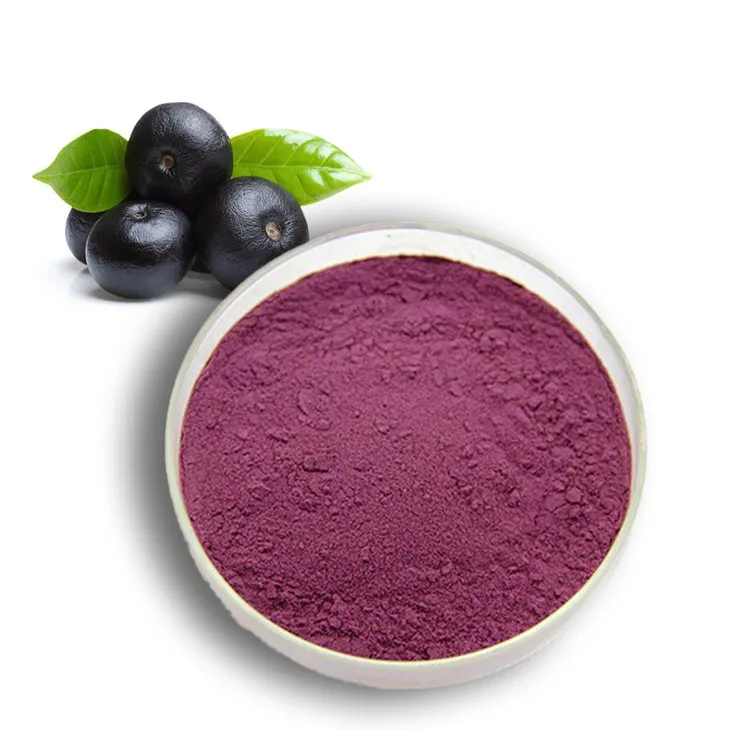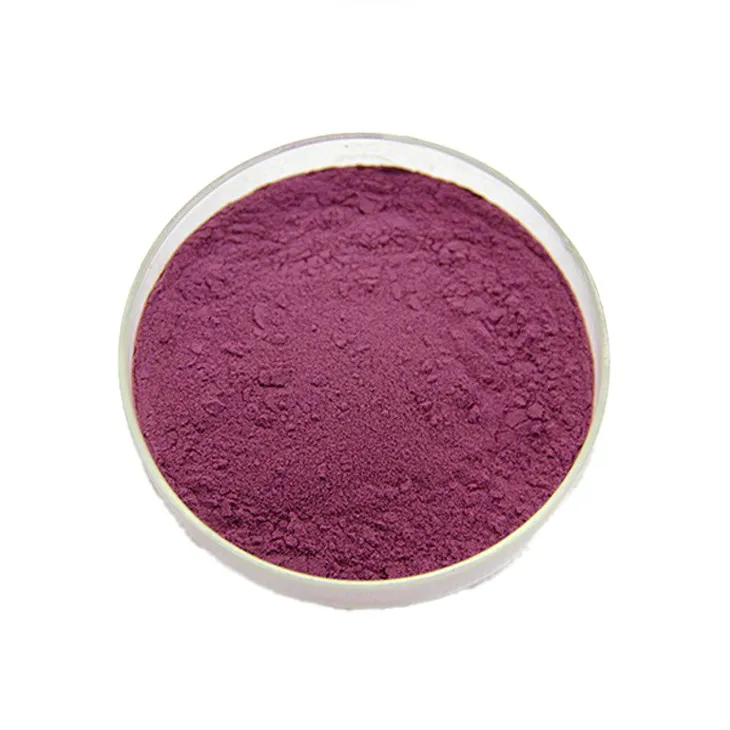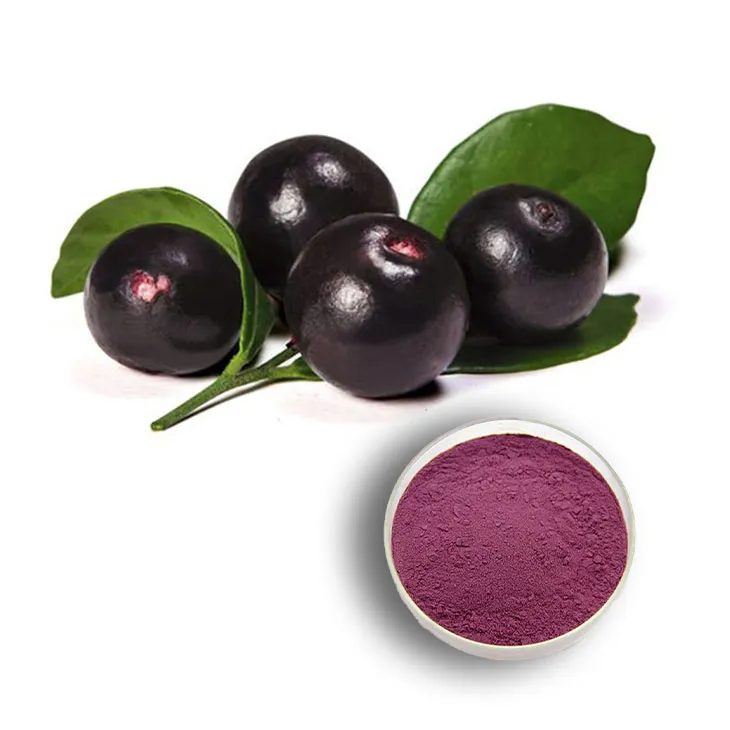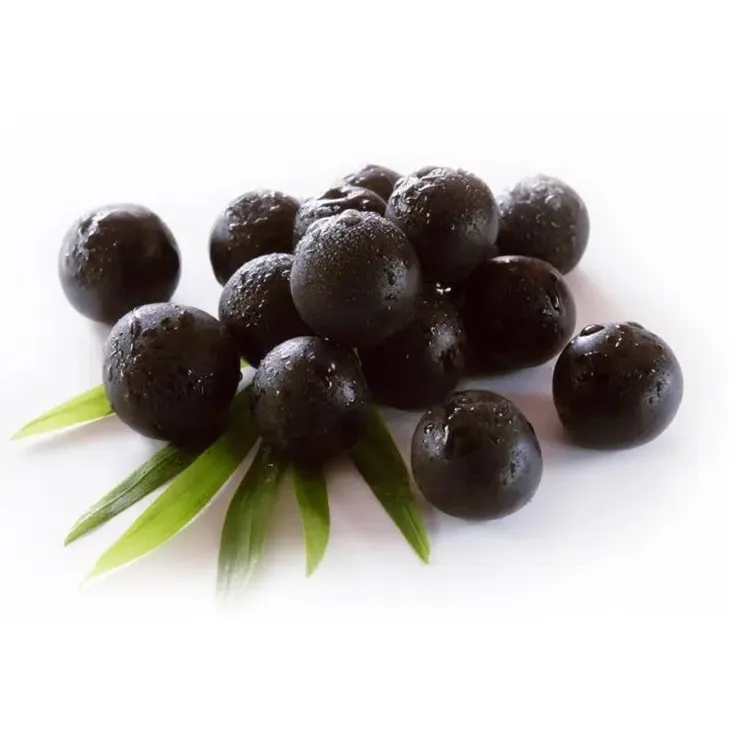- 0086-571-85302990
- sales@greenskybio.com
Acai Berry Extract: From Leaves to Extraction.
2024-11-13

1. Introduction to Acai Berries
Acai berries, native to the Amazon rainforests of Brazil, have become a global sensation in recent years. These small, purple berries are not only a staple in the traditional Brazilian diet but also have gained significant popularity in the health and beauty industries worldwide. The acai palm tree, Euterpe oleracea, is a remarkable plant that provides much more than just the berries. The leaves of the acai palm play an important role in the overall life cycle and ecosystem of the plant.

2. The Acai Palm Leaves: An Integral Part of the Ecosystem
2.1. Leaf Structure and Function
The leaves of the acai palm are long, feather - like fronds that are designed to capture sunlight efficiently. They are arranged in a way that maximizes the exposure to sunlight, which is crucial for photosynthesis. The leaves have a complex network of veins that transport water and nutrients throughout the leaf, ensuring its proper growth and function. Through photosynthesis, the leaves convert carbon dioxide and water into glucose and oxygen, providing the energy source for the entire plant.
2.2. Role in the Ecosystem
The acai palm leaves also play a significant role in the local ecosystem. They provide shelter and nesting sites for a variety of animals, including birds and small mammals. As the leaves age and fall to the ground, they decompose, adding organic matter to the soil. This enriches the soil, making it more fertile and suitable for the growth of other plants in the rainforest. Additionally, the leaves help to regulate the microclimate around the acai palm tree by providing shade and reducing evaporation.
3. Harvesting of Acai Berries
3.1. Seasonal Considerations
The harvesting of acai berries is highly dependent on the season. In Brazil, the acai berry season typically occurs from December to June. During this time, the berries ripen and are ready for harvest. It is important to harvest the berries at the right time to ensure optimal quality and nutrient content. If the berries are harvested too early, they may not have fully developed their characteristic flavor and nutritional profile. On the other hand, if they are left on the tree for too long, they may become overripe and spoil more quickly.
3.2. Harvesting Methods
There are two main methods of harvesting acai berries: traditional and modern.- Traditional Harvesting: In traditional harvesting, local communities in Brazil often use long poles to knock the clusters of berries from the tops of the acai palm trees. This method is labor - intensive but has been practiced for generations. It requires skilled workers who can accurately target the ripe berry clusters without damaging the tree or the surrounding environment.
- Modern Harvesting: With the increasing demand for acai berries in the global market, modern harvesting techniques have been developed. These include the use of mechanical harvesters, which can reach the higher branches of the trees more efficiently. However, care must be taken to ensure that these machines do not cause excessive damage to the trees or the surrounding ecosystem.

4. The Extraction Process
4.1. Initial Preparation
Once the acai berries are harvested, they need to be quickly processed to prevent spoilage. The first step in the extraction process is to wash the berries thoroughly to remove any dirt, debris, or other contaminants. After washing, the berries are sorted to remove any unripe or damaged ones. This ensures that only high - quality berries are used for extraction.
4.2. Extraction Methods
There are several methods for extracting the valuable compounds from acai berries.- Cold - Press Extraction: Cold - press extraction is a popular method as it helps to preserve the delicate nutrients and bioactive compounds in the acai berries. In this method, the berries are mechanically pressed without the use of heat. This gentle process squeezes out the juice, which contains a high concentration of antioxidants, vitamins, and minerals.
- Solvent Extraction: Solvent extraction involves the use of solvents such as ethanol or hexane to dissolve the desired compounds from the acai berries. This method can be more efficient in extracting certain types of bioactive compounds, but it requires careful control of the solvent - to - berry ratio and extraction time to avoid contamination and ensure product safety.
- Supercritical Fluid Extraction: Supercritical fluid extraction is a more advanced technique that uses supercritical fluids, such as carbon dioxide, as the extracting agent. This method offers several advantages, including high selectivity, low environmental impact, and the ability to extract a wide range of compounds without using harsh solvents.
4.3. Purification and Concentration
After the initial extraction, the resulting extract may contain impurities or be too dilute for certain applications. Therefore, purification and concentration steps are often necessary. Purification can be achieved through filtration, centrifugation, or chromatography techniques to remove any remaining solids or unwanted substances. Concentration methods, such as evaporation or freeze - drying, are then used to increase the concentration of the active compounds in the extract.
5. Nutrients and Bioactive Compounds in Acai Berry Extract
Acai Berry Extract is rich in a variety of nutrients and bioactive compounds that contribute to its many health - promoting properties.
- Antioxidants: One of the most notable components of Acai Berry Extract is its high antioxidant content. Antioxidants such as anthocyanins, flavonoids, and phenolic acids help to neutralize free radicals in the body. Free radicals are unstable molecules that can cause oxidative stress, which is linked to various diseases such as cancer, heart disease, and neurodegenerative disorders.
- Vitamins and Minerals: The extract also contains essential vitamins such as vitamin A, C, and E, as well as minerals like potassium, calcium, and magnesium. These nutrients play important roles in maintaining overall health, including supporting the immune system, promoting healthy skin, and regulating blood pressure.
- Omega - 3 Fatty Acids: Acai berries are a good source of omega - 3 fatty acids, which are beneficial for heart health. Omega - 3 fatty acids can help to reduce inflammation in the body, lower triglyceride levels, and improve blood lipid profiles.
- Fiber: The extract contains dietary fiber, which is important for digestive health. Fiber helps to promote regular bowel movements, prevent constipation, and may also play a role in reducing the risk of certain types of cancer.
6. Applications in the Health Industry
6.1. Dietary Supplements
Due to its rich nutrient profile, acai berry extract is commonly used in dietary supplements. These supplements are available in various forms, such as capsules, tablets, and powders. They are often marketed as a natural way to boost energy, improve immunity, and support overall health. However, it is important to note that the effectiveness of these supplements may vary depending on factors such as the quality of the extract, the dosage, and individual health conditions.
6.2. Functional Foods
Acai berry extract is also incorporated into functional foods, which are foods that provide additional health benefits beyond basic nutrition. For example, acai berry extract can be added to smoothies, yogurts, and energy bars. These products are popular among health - conscious consumers who are looking for convenient ways to incorporate more nutrients into their diets.
6.3. Medicinal Potential
There is ongoing research into the medicinal potential of acai berry extract. Some studies have suggested that it may have anti - inflammatory, anti - cancer, and anti - diabetic properties. However, more research is needed to fully understand the mechanisms of action and to determine the safety and effectiveness of using acai berry extract for medical purposes.7. Applications in the Beauty Industry
7.1. Skin Care Products
Acai berry extract has found its way into a wide range of skin care products. The antioxidants in the extract can help to protect the skin from environmental damage, such as UV radiation and pollution. It may also help to reduce the signs of aging, such as wrinkles and fine lines, by promoting collagen production. Additionally, the extract's anti - inflammatory properties can be beneficial for treating skin conditions such as acne and eczema.
7.2. Hair Care Products
In hair care, acai berry extract can be used to improve the health and appearance of hair. It can help to strengthen hair follicles, prevent hair loss, and add shine to the hair. The nutrients in the extract, such as vitamins and minerals, can nourish the scalp and promote healthy hair growth.8. Conclusion
The journey from the acai palm leaves to the extraction of the valuable acai berry extract is a complex and fascinating process. The acai berry, with its rich nutrient and bioactive compound content, has a wide range of applications in both the health and beauty industries. As research continues to explore its potential benefits, it is likely that the demand for acai berry extract will continue to grow. However, it is important to ensure sustainable harvesting practices and proper extraction methods to preserve the integrity of this precious natural resource.
FAQ:
What are the main antioxidant components in acai berry extract?
The acai berry extract is rich in antioxidants such as anthocyanins, flavonoids, and phenolic acids. These components play a significant role in neutralizing free radicals in the body, which may contribute to various health benefits.
How are acai berries harvested?
Acai berries are harvested from the acai palm. Usually, workers climb the palms to cut down the bunches of berries. It is a labor - intensive process as the acai palms can be quite tall. Care is taken to ensure that the berries are collected at the right stage of ripeness for the best quality.
What are the steps in the extraction process of acai berry extract?
The extraction process typically involves several steps. First, the acai berries are sorted and cleaned. Then, they may be crushed or mashed to break down the cell walls. After that, a solvent (which could be water or an organic solvent in some cases) is used to extract the bioactive compounds. The resulting mixture is then filtered and concentrated to obtain the final acai berry extract.
What are the applications of acai berry extract in the health industry?
In the health industry, acai berry extract is believed to have potential anti - inflammatory properties, may support heart health by helping to regulate cholesterol levels, and could also boost the immune system due to its antioxidant content. It is also being studied for its potential role in anti - aging and in promoting healthy digestion.
How is acai berry extract used in the beauty industry?
Acai berry extract is used in the beauty industry in various ways. It is often included in skincare products such as creams and serums because of its antioxidant properties which can help protect the skin from environmental damage. It may also be used in haircare products to promote healthy hair growth and improve hair texture.
Related literature
- The Antioxidant Potential of Acai Berry (Euterpe oleracea Mart.): A Review"
- "Acai Berry Extract: Properties, Processing, and Applications in the Food and Nutraceutical Industries"
- "Bioactive Compounds in Acai Berry and Their Role in Health Promotion"
- ▶ Hesperidin
- ▶ Citrus Bioflavonoids
- ▶ Plant Extract
- ▶ lycopene
- ▶ Diosmin
- ▶ Grape seed extract
- ▶ Sea buckthorn Juice Powder
- ▶ Fruit Juice Powder
- ▶ Hops Extract
- ▶ Artichoke Extract
- ▶ Mushroom extract
- ▶ Astaxanthin
- ▶ Green Tea Extract
- ▶ Curcumin
- ▶ Horse Chestnut Extract
- ▶ Other Product
- ▶ Boswellia Serrata Extract
- ▶ Resveratrol
- ▶ Marigold Extract
- ▶ Grape Leaf Extract
- ▶ New Product
- ▶ Aminolevulinic acid
- ▶ Cranberry Extract
- ▶ Red Yeast Rice
- ▶ Red Wine Extract
-
Green coffee bean Extract
2024-11-13
-
White Willow Bark Extract
2024-11-13
-
Cocoa Extract
2024-11-13
-
Giant Knotweed Extract
2024-11-13
-
Red Vine Extract
2024-11-13
-
Sophora Flavescens Root Extract
2024-11-13
-
Plantain extract
2024-11-13
-
Epimedium extract powder
2024-11-13
-
Kelp Extract Powder
2024-11-13
-
Mulberry Extract
2024-11-13





















